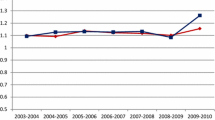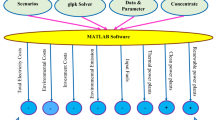Abstract
Improving environmental efficiency of thermal power plants is a crucial way to realize green and sustainable development. This paper investigates environmental efficiency of thermal power plants in China in 2011, 2013, and 2015 by conceptualizing a modified super-efficiency slacks-based measure with materials balance principle (MBP), which also eliminates the infeasibility in Malmquist–Luenberger index (MLI). An improved MLI is proposed based on the new efficiency measure. The results show that (1) the thermal power plants in most provinces have high environmental efficiency and productivity. (2) The improvement of productivity mainly originates from technical progress. This study provides a new perspective for environmental efficiency measurement on thermal power plants and advances related studies by (1) considering the first law of thermodynamics and introducing MBP in measuring environmental efficiency of thermal power plants and (2) defining a new MLI that captures the efficiency change and technical change in a super-efficiency framework. The thermal power plants in China can improve their environmental performance based on the results of current study.





Similar content being viewed by others
Availability of data and materials
The data that support the findings of this study are available from National Bureau of Statistics of China, but restrictions apply to the availability of these data, which were used under license for the current study, and so are not publicly available. Data are however available from the authors upon reasonable request and with permission of National Bureau of Statistics of China.
References
Amsler C, Prokhorov A, Schmidt P (2017) Endogenous environmental variables in stochastic frontier models. J Econ 199(2):131–140
Andersen P, Petersen NC (1993) A procedure for ranking efficient units in data envelopment analysis. Manage 39(10):1261–1264
Anser MK, Iqbal W, Ahmad US, Fatima A, Chaudhry IS (2020) Environmental efficiency and the role of energy innovation in emissions reduction. Environ Sci Pollut Res 23:1203–1213
Arabi B, Doraisamy SM, Emrouznejad A, Khoshroo A (2017) Eco-efficiency measurement and material balance principle: an application in power plants Malmquist Luenberger Index. Ann Oper Res 255(1-2):221–239
Arabi B, Munisamy S, Emrouznejad A (2015) A new slacks-based measure of Malmquist-Luenberger index in the presence of undesirable outputs. Omega 51:29–37
Ayres RU, Kneese AV (1969) Production, consumption, and externalities. Am Econ Rev 59(3):282–297
Caves DW, Christensen LR, Diewert WE (1982) The economic theory of index numbers and the measurement of input, output, and productivity. Econometrica 50:1393–1414
Charnes A, Cooper WW, Rhodes E (1978) Measuring the efficiency of decision making units. Eur J Oper Res 2(6):429–444
Chen K, Yang G, Khoveyni M (2017) Measuring performance evolution of academic journals in management science and operations research: a DEA-Malmquist approach. Journal of Management Science and Engineering 2(1):34–54
China Energy News (2021). https://www.powerchina.cn/art/2021/1/27/art_7459_1004342.html. Accessed 2 Mar 2021
Choi Y, Oh DH, Zhang N (2015) Environmentally sensitive productivity growth and its decompositions in China: a metafrontier Malmquist-Luenberger productivity index approach. Empir Econ 49(3):1017–1043
Chung YH (1996) Directional distance functions and undesirable outputs. Southern Illinois University, Carbondale
Chung YH, Färe R, Grosskopf S (1997) Productivity and undesirable outputs: a directional distance function approach. J Environ Manag 51(3):229–240
Coelli T, Lauwers L, Van Huylenbroeck G (2007) Environmental efficiency measurement and the materials balance condition. J Prod Anal 28(1-2):3–12
Coelli T, Perelman S, Romano E (1999) Accounting for environmental influences in stochastic frontier models: with application to international airlines. J Prod Anal 11(3):251–273
Ding L, Yang Y, Wang W, Calin AC (2019) Regional carbon emission efficiency and its dynamic evolution in China: a novel cross efficiency-malmquist productivity index. J Clean Prod 241:118260
EIA (2014) Energy Information Agency. International Energy Statistics. http://www.eia.gov/countries/data.cfm. Accessed 27 Feb 2021
Expósito A, Velasco F (2020) Exploring environmental efficiency of the European agricultural sector in the use of mineral fertilizers. J Clean Prod 253:119971
Färe R, Grosskopf S (1997) Intertemporal production frontiers: with dynamic DEA. J Oper Res Soc 48(6):656–656
Färe R, Grosskopf S, Norris M, Zhang Z (1994) Productivity growth, technical progress, and efficiency change in industrialized countries. Am Econ Rev 84(1):66e83
Färe R, Grosskopf S (2010) Directional distance functions and slacks-based measures of efficiency. Eur J Oper Res 200(1):320–322
Førsund FR (2018) Multi-equation modelling of desirable and undesirable outputs satisfying the materials balance. Empir Econ 54(1):67–99
Fried HO, Lovell CK, Schmidt SS, Yaisawarng S (2002) Accounting for environmental effects and statistical noise in data envelopment analysis. J Prod Anal 17(1-2):157–174
Hampf B, Rødseth KL (2015) Carbon dioxide emission standards for US power plants: An efficiency analysis perspective. Energy Econ 50:140–153
Han Y, Zhou R, Geng Z, Bai J, Ma B, Fan J (2020) A novel data envelopment analysis cross-model integrating interpretative structural model and analytic hierarchy process for energy efficiency evaluation and optimization modeling: application to ethylene industries. J Clean Prod 246:118965
Hermoso-Orzáez MJ, García-Alguacil M, Terrados-Cepeda J, Brito P (2020). Measurement of environmental efficiency in the countries of the European Union with the enhanced data envelopment analysis method (DEA) during the period 2005-2012. Environ Sci Pollut Res (7493)
IEA (2014) CO2 emissions from fuel combustion 2014. OECD/IEA, Paris
IPCC (2006) IPCC guidelines for National Greenhouse Gas Inventories. http://www.ipccnggip.iges.or.jp/public/2006gl/vol2.html. Accessed 10 Mar 2021
Lauwers L (2009) Justifying the incorporation of the materials balance principle into frontier-based eco-efficiency models. Ecol Econ 68(6):1605–1614
Lee HS, Zhu J (2012) Super-efficiency infeasibility and zero data in DEA. Eur J Oper Res 216(2):429–433
Long R, Ouyang H, Guo H (2020) Super-slack-based measuring data envelopment analysis on the spatial-temporal patterns of logistics ecological efficiency using global Malmquist Index model. Environ Technol Innov 18:100770
Lin R, Li Z (2019) Directional distance based diversification super-efficiency DEA models for mutual funds. Omega 97:102096
Liu FHF, Wang PH (2008) DEA Malmquist productivity measure: Taiwanese semiconductor companies. Int J Prod Econ 112(1):367–379
Liu T, Gao Q, Wu F (2019) Research on spatial differentiation of technological innovation efficiency of enterprise based on the super-efficiency DEA-Malmquist model. In: In 2nd International Conference on Economy, Management and Entrepreneurship (ICOEME 2019). Press, Atlantis
National Bureau of Statistics, China (2016) China energy statistics yearbook (2012, 2014, 2016). China Statistics Press, Beijing
National Bureau of Statistics, China (2016) China environmental statistics annual report (2012, 2014, 2016). China Statistics Press, Beijing
National Bureau of Statistics, China (2016) China industry yearbooks (2012, 2014, 2016). China Statistics Press Beijing
National Bureau of Statistics of China (2018)
National Development and Reform Commission (NDRC) (2007) National Greenhouse Gas Inventory of the People’s Republic of China (in Chinese). Chinese Environmental Science Press, Beijing
Oh DH (2010) A global Malmquist-Luenberger productivity index. J Prod Anal 34(3):183–197
Pastor JT, Asmild M, Lovell CK (2011) The biennial Malmquist productivity change index. Socio-Econ Plan Sci 45(1):10–15
Pethig R (2003) The “material balance approach” to pollution: its origin, implications and acceptance. Discussion paper, University of Siegen
Rødseth KL (2013) Capturing the least costly way of reducing pollution: a shadow price approach. Ecol Econ 92:16–24
Rødseth KL (2016) Environmental efficiency measurement and the materials balance condition reconsidered. Eur J Oper Res 250(1):342–346
Shao L, Yu X, Feng C (2019) Evaluating the eco-efficiency of China’s industrial sectors: a two-stage network data envelopment analysis. J Environ Manag 247:551–560
Sun J, Du T, Sun W, Na H, He J, Qiu Z et al (2019) An evaluation of greenhouse gas emission efficiency in China's industry based on SFA. Sci Total Environ 690:1190–1202
Tone K (2001) A slacks-based measure of efficiency in data envelopment analysis. Eur J Oper Res 130(3):498–509
Wang EC (2007) R&D efficiency and economic performance: a cross-country analysis using the stochastic frontier approach. J Policy Model 29(2):345–360
Wang K, Lee CY, Zhang J, Wei YM (2018a) Operational performance management of the power industry: a distinguishing analysis between effectiveness and efficiency. Ann Oper Res 268(1-2):513–537
Wang K, Mi Z, Wei YM (2019a) Will pollution taxes improve joint ecological and economic efficiency of thermal power industry in China?: A DEA-Based Materials Balance Approach. J Ind Ecol 23(2):389–401
Wang K, Wei YM, Huang Z (2018b) Environmental efficiency and abatement efficiency measurements of China’s thermal power industry: a data envelopment analysis based materials balance approach. Eur J Oper Res 269(1):35–50
Wang X, Ding H, Liu L (2019b) Eco-efficiency measurement of industrial sectors in China: a hybrid super-efficiency DEA analysis. J Clean Prod 229:53–64
Wang X, Wang Y (2020) Regional unified environmental efficiency of China: a non-separable hybrid measure under natural and managerial disposability. Environ Sci Pollut Res 1-17
Wanke P, Chen Z, Zheng X, Antunes J (2020) Sustainability efficiency and carbon inequality of the Chinese transportation system: a robust Bayesian stochastic frontier analysis. J Environ Manag 260:110163
Wu F, Fan LW, Zhou P, Zhou DQ (2012) Industrial energy efficiency with CO2 emissions in China: a nonparametric analysis. Energy Policy 49:164–172
Yang L, Zhang X (2018) Assessing regional eco-efficiency from the perspective of resource, environmental and economic performance in China: a bootstrapping approach in global data envelopment analysis. J Clean Prod 173:100–111
Yao X, Zhou H, Zhang A, Li A (2015) Regional energy efficiency, carbon emission performance and technology gaps in China: a meta-frontier non-radial directional distance function analysis. Energy Policy 84:142–154
Zeng X, Zhou Z, Liu Q, Xiao H, Liu W (2020) Environmental efficiency and abatement potential analysis with a two-stage DEA model incorporating the material balance principle. Comput Ind Eng 148:106647
Zhou P, Ang BW, Poh KL (2008) A survey of data envelopment analysis in energy and environmental studies. Eur J Oper Res 189(1):1–18
Funding
The research is supported by the National Natural Science Foundation of China (Nos. 71871223, 72091515 and 91846301) and Innovation-Driven Planning Foundation of Central South University (2019CX041).
Author information
Authors and Affiliations
Contributions
Qingxian An: Methodology; Supervision; Validation; Visualization; Writing; Funding acquisition; Project administration. Jing Zhao: Conceptualization; Formal analysis; Methodology; Supervision; Validation; Visualization; Writing (original draft); Writing (editing). Xiangyang Tao: Methodology; Writing (review and editing); Editing assistance. Zongrun Wang: Supervision; funding acquisition; project administration.
Corresponding author
Ethics declarations
Ethical approval
Not applicable.
Consent to participate
Not applicable.
Consent to publish
Not applicable.
Competing interests
The authors declare no competing interests.
Additional information
Responsible Editor: Philippe Garrigues
Publisher’s note
Springer Nature remains neutral with regard to jurisdictional claims in published maps and institutional affiliations.
Rights and permissions
About this article
Cite this article
An, Q., Zhao, J., Tao, X. et al. Measuring environmental efficiency of thermal power plants in China: an improved Malmquist–Luenberger index with materials balance principle. Environ Sci Pollut Res 28, 42853–42867 (2021). https://doi.org/10.1007/s11356-021-13740-w
Received:
Accepted:
Published:
Issue Date:
DOI: https://doi.org/10.1007/s11356-021-13740-w




